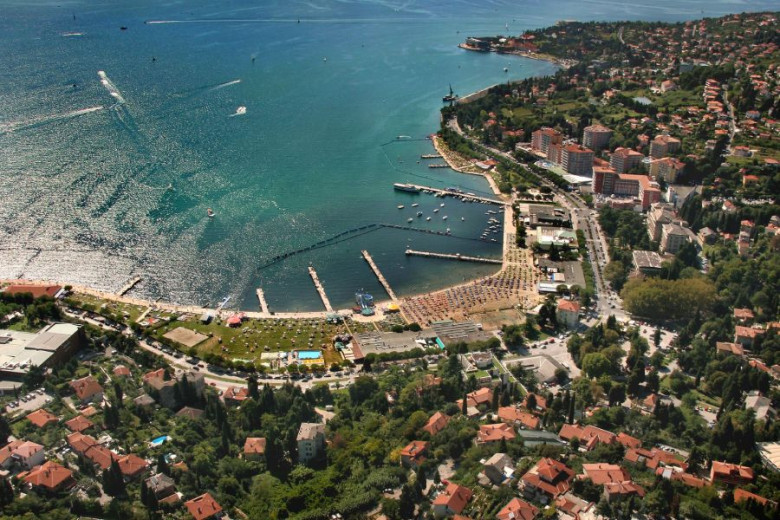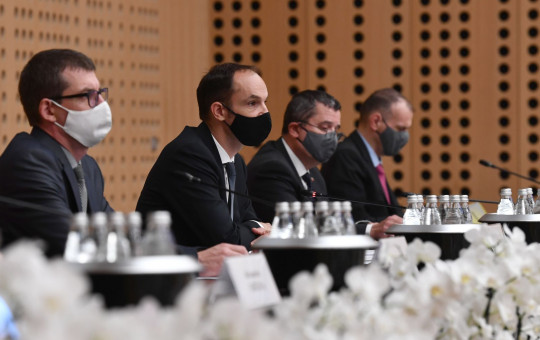Date: 25. May 2021
Time to read: 2 min
Around 190 events will be held during the Slovenian Presidency, from an informal meeting of heads of state and government, to ministerial meetings and conferences, along with expert meetings at lower levels. In the desire to show Slovenia to foreign guests and bring the Presidency closer to Slovenes and local communities, the meetings will take place in multiple locations around the country. The main venues will be Brdo pri Kranju, Ljubljana, Bled, Portorož, Maribor and Postojna. In the case of an unfavourable epidemiological situation, the events will be held using video-conferencing.
Main venue of meetings at the highest political level – Brdo pri Kranju
Slovenia will host around 190 events during its Presidency. The Brdo pri Kranju Congress Centre built for the first Slovenian Presidency of the EU Council will be the main venue for high-level meetings. This is one of the most advanced centres for the organisation of protocol, business and other events in Slovenia. Its location is part of the Brdo Estate, which takes pride in more than five hundred years of history. The main part of the estate includes the Renaissance castle at Brdo which was home to noble dynasties from the 15th century on, while today it is used for state functions and ceremonial duties.
The estate of nearly five hundred acres is situated in a beautiful natural setting with a backdrop of mountains. Close to the castle and the Congress Centre are also an equestrian centre, a golf course, a hotel and the National Football Centre. When in the central park, guests can see a precious collection of statues, a Slovenian beehive and thatched-roof double hayracks, or toplars.
Capital of Slovenia – Ljubljana
Ljubljana, the capital of Slovenia, is the vibrant political, university, cultural and congress centre of the country. The main attraction of Ljubljana is the medieval castle. The picturesque old town centre along the River Ljubljanica was designed by Slovenia’s most renowned architect, Jože Plečnik, in the first half of the 20th century.
With more than 542 m2 of public green spaces per inhabitant, Ljubljana is one of the greenest cities in Europe. In 2016, the city authorities' efforts to ensure sustainable development were rewarded with the title of European Green Capital. The city centre has been pedestrianised and closed to motor vehicles since 2008, and Ljubljana is also known for its successful zero waste strategy.
Natural treasure – Bled
The Alpine lake with an island and a church on it is probably the most famous image of Slovenia in the world. This small town on the edge of the Triglav National Park attracted its first tourists with spa tourism, but today it is visited for its unique natural beauty. A ride in a traditional pletna boat is a rare experience, and almost all visitors treat themselves to a slice of the famous Bled cream cake.
In 2019 Bled was selected as the second best place for sustainable development in Europe, and it’s a perfect starting point for hikes to the heart of the Julian Alps. The town is also a centre of congress tourism, hosting the annual Bled Strategic Forum, one of the leading international conferences in Central and South East Europe.
Seaside resort with a long-standing tradition – Portorož
The main tourist resort along the Slovenian coast boasts a long tradition directly connected with the utilisation of the active ingredients of the local salt and seawater. Monks from the Monastery of St Lawrence treated people with seawater and brine back in the Middle Ages, and today these services are offered to visitors in health spas and wellness centres. The opportunity to combine pleasure with a learning experience, plus hotels with suitable conference facilities, have turned Portorož into a popular congress destination.
The Strunjan Nature Park and the Sečovlje Salina Nature Park are in the immediate vicinity of Portorož, and the medieval town of Piran, the cultural pearl of the Slovenian Riviera, is only three kilometres away. Portorož makes the perfect starting point for many sports activities and culinary experiences in the inland part of Slovenian Istria.
Slovenia's second-largest city – Maribor
Maribor is the second biggest city in the country, the unofficial capital of the Štajerska region, and the economic, educational, congress and cultural centre of north-eastern Slovenia. The city is closely connected with the River Drava, and the green hills of Pohorje not far away are a popular destination for hikers in all seasons.
The Štajerska region has an extraordinarily rich wine-growing tradition and top-quality wines, and the old town centre of Maribor is home to the world’s oldest grapevine. A heart-shaped bicycle trail weaves its way through the vineyards above the village of Svečina in the Maribor countryside, one of the most photographed places in Slovenia.
On the edge of the mysterious karst world – Postojna
Postojna is an urban settlement in the Notranjska region, at the junction of the coastal and inland regions of Slovenia. The characteristics of the karst lands include various karst phenomena, including numerous caves of which Postojna Cave is the most frequently visited. Its 24-kilometer system of subterranean chambers is home to various animal species, with the most famous being the olm, or “human fish” (Proteus anguinus). It is the only karst cave with a cave railway, and numerous events are held in the larger cave chambers, from concerts to the staging of a live nativity scene each Christmas. Located close to Postojna is the famous Predjama Castle, the largest cave castle in the world.










